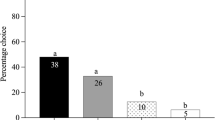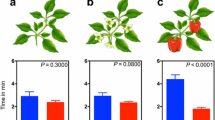Abstract
Herbivore-induced plant volatiles (HIPVs) are important cues for natural enemies to find their hosts. HIPVs are usually present as blends and the effects of combinations of individual components are less studied. Here, we investigated plant volatiles in a tritrophic system, comprising the parasitoid wasp Lytopylus rufipes Nees (Hymenoptera: Braconidae), the Oriental fruit moth Grapholita molesta (Busck) (Lepidoptera: Tortricidae), and Japanese pear, Pyrus pyrifolia ‘Kosui’, so as to elucidate the effects of single components and blends on wasp behaviors. Bioassays in a four-arm olfactometer, using either shoots or their isolated volatiles collected on adsorbent, revealed that female wasps preferred volatiles from host-infested shoots over those from intact shoots. Analyses identified (Z)-3-hexenyl acetate (H), linalool (L), (E)-β-ocimene (O), (E)-3,8-dimethyl-1,4,7-nonatriene (D), and (E,E)-α-farnesene (F). Among them, only F was induced by infestation with G. molesta. When tested singly, only O and D elicited positive responses by L. rufipes. Binary blends of HO and DF elicited a positive response, but that of HD elicited a negative one, even though D alone elicited a positive response. Remarkably, wasps did not prefer either the ODF or HL blends, but showed a highest positive response to a quinary blend (HLODF). These results show that synergism among volatiles released from host-infested plants is necessary for eliciting high behavioral responses in L. rufipes, enabling L. rufipes to find its host efficiently.





Similar content being viewed by others
References
Allen BW (1962) Parasites of the oriental fruit moth in the eastern United States. USDA Tech Bull No 1265
Allen HW, Yetter WP (1949) Bassus diversus, an oriental fruit moth parasite established in the United States. J Econ Entomol 42:540. https://doi.org/10.1093/jee/42.3.540
Büchel K, Malskies S, Mayer M, Fenning TM, Gershenzon J, Hilker M, Meiners T (2011) How plants give early herbivore alert: volatile terpenoids attract parasitoids to egg-infested elms. Basic Appl Ecol 12:403–412. https://doi.org/10.1016/j.baae.2011.06.002
Büchel K, Austel N, Mayer M, Gershenzon J, Fenning TM, Meiners T (2014) Smelling the tree and the forest: elm background odours affect egg parasitoid orientation to herbivore induced terpenoids. BioControl 59:29–43. https://doi.org/10.1007/s10526-013-9544-9
Collatz J, Dorn S (2013) Tritrophic consequences arising from a host shift between apple and walnut in an oligophagous herbivore. Biol Control 65:330–337. https://doi.org/10.1016/j.biocontrol.2013.03.011
Dicke M, Hilker M (2003) Induced plant defences: from molecular biology to evolutionary ecology. Basic Appl Ecol 4:3–14. https://doi.org/10.1078/1439-1791-00129
Dicke M, Van Beek TA, Posthumus MA et al (1990) Isolation and identification of volatile kairomone that affects acarine predator–prey interactions involvement of host plant in its production. J Chem Ecol 16:381–396. https://doi.org/10.1007/BF01021772
Fontana A, Held M, Fantaye CA, Turlings TC, Degenhardt J, Gershenzon J (2011) Attractiveness of constitutive and herbivore-induced sesquiterpene blends of maize to the parasitic wasp Cotesia marginiventris (Cresson). J Chem Ecol 37:582–591. https://doi.org/10.1007/s10886-011-9967-7
Fujinuma M, Kainoh Y, Nemoto H (2010) Borago officinalis attracts the aphid parasitoid Aphidius colemani (Hymenoptera: Braconidae). Appl Entomol Zool 45:615–620. https://doi.org/10.1303/aez.2010.615
Hern A, Dorn S (2003) Monitoring seasonal variation in apple fruit volatile emissions in situ using solid-phase microextraction. Phytochem Anal 14:232–240. https://doi.org/10.1002/pca.709
Il’Ichev AL, Kugimiya S, Williams DG, Takabayashi J (2009) Volatile compounds from young peach shoots attract males of oriental fruit moth in the field. J Plant Interact 4:289–294. https://doi.org/10.1080/17429140903267814
Jones VP, Horton DR, Mills NJ, Unruh TR, Baker CC, Melton TD, Miliczky ER, Steffan SA, Shearer PW, Amarasekare K (2015) Evaluating herbivore-induced plant volatiles and floral volatiles for monitoring natural enemies in apple, pear and walnut orchards. Biol Control 102:53–65. https://doi.org/10.1016/j.biocontrol.2015.03.009
Kanga LHB, Pree DJ, van Lier JL, Walker GM (2003) Management of insecticide resistance in oriental fruit moth (Grapholita molesta; Lepidoptera: Tortricidae) populations from Ontario. Pest Manag Sci 59:921–927. https://doi.org/10.1002/ps.702
Kobayashi K, Arai M, Tanaka A, Matsuyama S, Honda H, Ohsawa R (2012) Variation in floral scent compounds recognized by honeybees in Brassicaceae crop species. Breed Sci 62:293–302. https://doi.org/10.1270/jsbbs.62.293
Kong WN, Li J, Fan RJ, Li SC, Ma RY (2014) Sex-pheromone-mediated mating disruption technology for the oriental fruit moth, Grapholita molesta (Busck) (Lepidoptera: Tortricidae): overview and prospects. Psyche. 2014:1–8. https://doi.org/10.1155/2014/253924
Krugner R, Wallis C, Walse S (2014) Attraction of the egg parasitoid, Gonatocerus ashmeadi Girault (Hymenoptera: Mymaridae) to synthetic formulation of a (E)-β-ocimene and (E,E)-α-farnesene mixture. Biol Control 77:23–28. https://doi.org/10.1016/j.biocontrol.2014.06.005
Leopold EJ (1986) Selective hydroboration of a 1,3,7-triene: homogeraniol. Org Synth 64:164–164. https://doi.org/10.1002/0471264180.os064.25
Mills NJ, Heimpel GE (2018) Could increased understanding of foraging behavior help to predict the success of biological control? Curr Opin Insect Sci 27:26–31. https://doi.org/10.1016/j.cois.2018.02.013
Mochizuki F (2009) Rearing method of the oriental fruit moth, Grapholita molesta, by an artificial diet. Proc Assoc Plant Prot Hokuriku 58:25–30 (in Japanese)
Mumm R, Dicke M (2010) Variation in natural plant products and the attraction of bodyguards involved in indirect plant defense. Can J Zool 88:628–667. https://doi.org/10.1139/Z10-032
Mumm R, Hilker M (2005) The significance of background odour for an egg parasitoid to detect plants with host eggs. Chem Senses 30:337–343. https://doi.org/10.1093/chemse/bji028
Najar-Rodriguez A, Orschel B, Dorn S (2013) Season-long volatile emissions from peach and pear trees in situ, overlapping profiles, and olfactory attraction of an oligophagous fruit moth in the laboratory. J Chem Ecol 39:418–429. https://doi.org/10.1007/s10886-013-0262-7
Nurkomar I, Pudjianto MS, Buchori D, Matsuyama S, Taylor DM, Kainoh Y (2017) (E,E)-α-Farnesene as a host-induced plant volatile that attracts Apanteles taragamae (Hymenoptera: Braconidae) to host-infested cucumber plants. Biocontrol Sci Tech 28:34–48. https://doi.org/10.1080/09583157.2017.1413340
Oliveira CM, Auad AM, Mendes SM, Frizzas MR (2013) Economic impact of exotic insect pests in Brazilian agriculture. J Appl Entomol 137:1–15. https://doi.org/10.1111/jen.12018
Piñero JC, Dorn S (2007) Synergism between aromatic compounds and green leaf volatiles derived from the host plant underlies female attraction in the oriental fruit moth. Entomol Exp Appl 125:185–194. https://doi.org/10.1111/j.1570-7458.2007.00614.x
R Core Team (2017) R: A Language and Environment for Statistical Computing. R Foundation for Statistical Computing, Vienna, Austria. Available online at https://www.R-project.org/
Rings RW (1970) Economic aspects of the biology and control of the oriental fruit moth, Grapholitha molesta Busck, in the United States. Ohio J Sci 70:58–61
Rott AS, Häckermann J, Brand N, Vallat A, Dorn S (2005) Parasitoid exploitation of the seasonal variation in host plant volatile emission for herbivore location. Entomol Exp Appl 115:199–205. https://doi.org/10.1111/j.1570-7458.2005.00276.x
Salamanca J, Souza B, Rodriguez-Saona C (2018) Cascading effects of combining synthetic herbivore-induced plant volatiles with companion plants to manipulate natural enemies in an agro-ecosystem. Pest Manag Sci 74:2133–2145. https://doi.org/10.1002/ps.4910
Sasaki M, Hoshi H, Kawaguchi E (2015) Seasonal prevalence of occurrence of Lytopylus rufipes parasitic on larvae of oriental fruit moth, Grapholita molesta in peach orchards. Ann Rept Plant Prot North Japan 66:153–156 (in Japanese. https://doi.org/10.11455/kitanihon.2015.66_153
Schröder R, Hilker M (2008) The relevance of background odor in resource location by insects: a behavioral approach. BioScience 58:308–316. https://doi.org/10.1641/B580406
Simpson M, Gurr GM, Simmons AT, Wratten SD, James DG, Leeson G, Nicol HI, Orre-Gordo GUS (2011a) Field evaluation of the “attract and reward” biological control approach in vineyards. Ann Appl Biol 159:69–78. https://doi.org/10.1111/j.1744-7348.2011.00477.x
Simpson M, Gurr GM, Simmons AT, Wratten SD, James DG, Leeson G, Nicol HI, Orre-Gordo GUS (2011b) Attract and reward: combining chemical ecology and habitat manipulation to enhance biological control in field crops. J Appl Ecol 48:580–590. https://doi.org/10.1111/j.1365-2664.2010.01946.x
Simpson M, Gurr GM, Simmons AT, Wratten SD, James DG, Leeson G, Nicol HI (2011c) Insect attraction to synthetic herbivore-induced plant volatile-treated field crops. Agric For Entomol 13:45–57. https://doi.org/10.1111/j.1461-9563.2010.00496.x
Suckling DM, Twidle AM, Gibb AR, Manning LM, Mitchell VJ, Sullivan TES, Wee SL, El-Sayed AM (2012) Volatiles from apple trees infested with light brown apple moth larvae attract the parasitoid Dolichogenidia tasmanica. J Agric Food Chem 60:9562–9566. https://doi.org/10.1021/jf302874g
Takemoto H, Takabayashi J (2015) Parasitic wasps Aphidius ervi are more attracted to a blend of host-induced plant volatiles than to the independent compounds. J Chem Ecol 41:801–807. https://doi.org/10.1007/s10886-015-0615-5
Thanikkul P, Piyasaengthong N, Menezes-Netto AC, Taylor DM, Kainoh Y (2017) Effects of quantitative and qualitative differences in volatiles from host- and non-host-infested maize on the attraction of the larval parasitoid Cotesia kariyai. Entomol Exp Appl 163:60–69. https://doi.org/10.1111/eea.12555
Turlings TCJ, Erb M (2018) Tritrophic interactions mediated by herbivore-induced plant volatiles: mechanisms, ecological relevance, and application potential. Annu Rev Entomol 63:433–452. https://doi.org/10.1146/annurev-ento-020117-043507
Turlings TCJ, Ton J (2006) Exploiting scents of distress: the prospect of manipulating herbivore-induced plant odours to enhance the control of agricultural pests. Curr Opin Plant Biol 9:421–427. https://doi.org/10.1016/j.pbi.2006.05.010
Vallat A, Dorn S (2005) Changes in volatile emissions from apple trees and associated response of adult female codling moths over the fruit-growing season. J Agric Food Chem 53:4083–4090. https://doi.org/10.1021/jf048499u
Van Wijk M, De Bruijn PJ, Sabelis MW (2008) Predatory mite attraction to herbivore-induced plant odors is not a consequence of attraction to individual herbivore-induced plant volatiles. J Chem Ecol 34:791–803. https://doi.org/10.1007/s10886-008-9492-5
Vet LEM, van Lenteren JC, Heymans M, Meelis E (1983) An airflow olfactometer for measuring olfactory responses of hymenopterous parasitoids and other small insects. Physiol Entomol 8:97–106. https://doi.org/10.1111/j.1365-3032.1983.tb00338.x
Webster B, Bruce T, Pickett J, Hardie J (2010) Volatiles functioning as host cues in a blend become nonhost cues when presented alone to the black bean aphid Volatiles functioning as host cues in a blend become nonhost cues when presented alone to the black bean aphid. Anim Behav 79:451–457. https://doi.org/10.1016/j.anbehav.2009.11.028
Woods JL, James DG, Lee JC, Gent DH (2011) Evaluation of airborne methyl salicylate for improved conservation biological control of two-spotted spider mite and hop aphid in Oregon hop yards. Exp Appl Acarol 55:401–416. https://doi.org/10.1007/s10493-011-9495-8
Yildizhan S, Schulz S (2011) Easy access to (E)-β-Ocimene. Synlett 2011:2831–2833. https://doi.org/10.1055/s-0031-12898
Yu DS, van Achterberg C, Horstmann K (2012) World Ichneumonoidea 2011. Taxonomy, biology, morphology and distribution. Taxapad (scientific names for information management) interactive catalogue, Ottawa. http://www.taxapad.com/ich2004.php (accessed 30.11.2018)
Acknowledgements
We appreciate the kind help of the following researchers: Mr. Masao Kaneko (Nagano Fruit Tree Experiment Station) for the moth colony; Mr. Masataka Sasaki (Fukushima Plant Protection Association) for the wasp colony; Dr. Masahiro Arakawa and Mr. Kouki Yoshida (Fruit Tree Research Center, Fukushima Prefecture) for preparing the thinned apples for insect rearing; Prof. Junko Sugaya (Faculty of Life and Environmental Sciences, University of Tsukuba) for the pear trees and advice on their care; and Prof. DeMar Taylor for English editing.
Author information
Authors and Affiliations
Corresponding author
Rights and permissions
About this article
Cite this article
Liu, CM., Matsuyama, S. & Kainoh, Y. Synergistic Effects of Volatiles from Host-Infested Plants on Host-Searching Behavior in the Parasitoid Wasp Lytopylus rufipes (Hymenoptera: Braconidae). J Chem Ecol 45, 684–692 (2019). https://doi.org/10.1007/s10886-019-01088-y
Received:
Revised:
Accepted:
Published:
Issue Date:
DOI: https://doi.org/10.1007/s10886-019-01088-y




